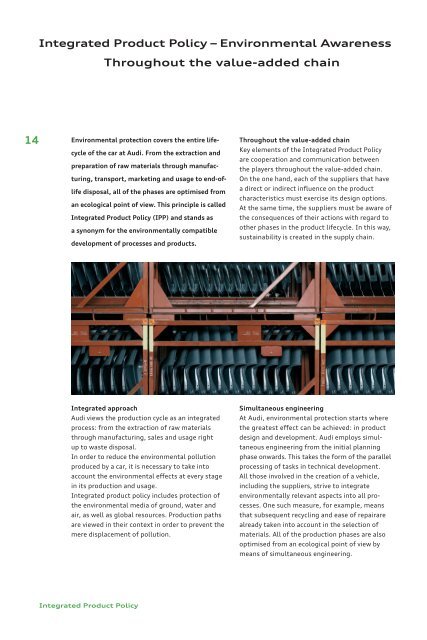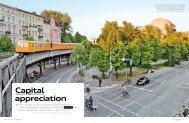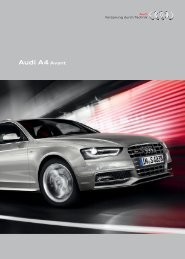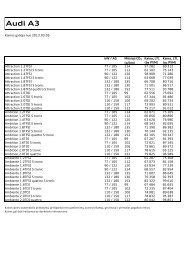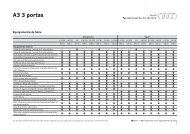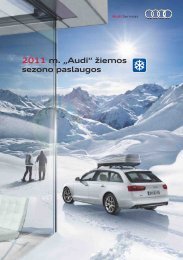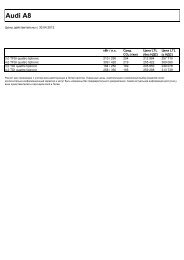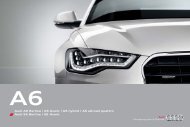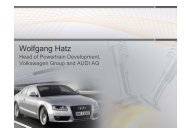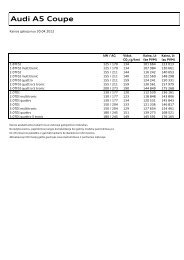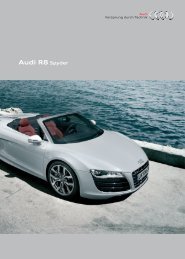Environmental Declaration 2010 for the Audi Plant in Ingolstadt
Environmental Declaration 2010 for the Audi Plant in Ingolstadt
Environmental Declaration 2010 for the Audi Plant in Ingolstadt
You also want an ePaper? Increase the reach of your titles
YUMPU automatically turns print PDFs into web optimized ePapers that Google loves.
14<br />
Integrated Product Policy – <strong>Environmental</strong> Awareness<br />
Throughout <strong>the</strong> value-added cha<strong>in</strong><br />
<strong>Environmental</strong> protection covers <strong>the</strong> entire life-<br />
cycle of <strong>the</strong> car at <strong>Audi</strong>. From <strong>the</strong> extraction and<br />
preparation of raw materials through manufac-<br />
tur<strong>in</strong>g, transport, market<strong>in</strong>g and usage to end-of-<br />
life disposal, all of <strong>the</strong> phases are optimised from<br />
an ecological po<strong>in</strong>t of view. This pr<strong>in</strong>ciple is called<br />
Integrated Product Policy (IPP) and stands as<br />
a synonym <strong>for</strong> <strong>the</strong> environmentally compatible<br />
development of processes and products.<br />
Integrated approach<br />
<strong>Audi</strong> views <strong>the</strong> production cycle as an <strong>in</strong>tegrated<br />
process: from <strong>the</strong> extraction of raw materials<br />
through manufactur<strong>in</strong>g, sales and usage right<br />
up to waste disposal.<br />
In order to reduce <strong>the</strong> environmental pollution<br />
produced by a car, it is necessary to take <strong>in</strong>to<br />
account <strong>the</strong> environmental effects at every stage<br />
<strong>in</strong> its production and usage.<br />
Integrated product policy <strong>in</strong>cludes protection of<br />
<strong>the</strong> environmental media of ground, water and<br />
air, as well as global resources. Production paths<br />
are viewed <strong>in</strong> <strong>the</strong>ir context <strong>in</strong> order to prevent <strong>the</strong><br />
mere displacement of pollution.<br />
Integrated Product Policy<br />
Throughout <strong>the</strong> value-added cha<strong>in</strong><br />
Key elements of <strong>the</strong> Integrated Product Policy<br />
are cooperation and communication between<br />
<strong>the</strong> players throughout <strong>the</strong> value-added cha<strong>in</strong>.<br />
On <strong>the</strong> one hand, each of <strong>the</strong> suppliers that have<br />
a direct or <strong>in</strong>direct <strong>in</strong>fluence on <strong>the</strong> product<br />
characteristics must exercise its design options.<br />
At <strong>the</strong> same time, <strong>the</strong> suppliers must be aware of<br />
<strong>the</strong> consequences of <strong>the</strong>ir actions with regard to<br />
o<strong>the</strong>r phases <strong>in</strong> <strong>the</strong> product lifecycle. In this way,<br />
susta<strong>in</strong>ability is created <strong>in</strong> <strong>the</strong> supply cha<strong>in</strong>.<br />
Simultaneous eng<strong>in</strong>eer<strong>in</strong>g<br />
At <strong>Audi</strong>, environmental protection starts where<br />
<strong>the</strong> greatest effect can be achieved: <strong>in</strong> product<br />
design and development. <strong>Audi</strong> employs simultaneous<br />
eng<strong>in</strong>eer<strong>in</strong>g from <strong>the</strong> <strong>in</strong>itial plann<strong>in</strong>g<br />
phase onwards. This takes <strong>the</strong> <strong>for</strong>m of <strong>the</strong> parallel<br />
process<strong>in</strong>g of tasks <strong>in</strong> technical development.<br />
All those <strong>in</strong>volved <strong>in</strong> <strong>the</strong> creation of a vehicle,<br />
<strong>in</strong>clud<strong>in</strong>g <strong>the</strong> suppliers, strive to <strong>in</strong>tegrate<br />
environmentally relevant aspects <strong>in</strong>to all processes.<br />
One such measure, <strong>for</strong> example, means<br />
that subsequent recycl<strong>in</strong>g and ease of repairare<br />
already taken <strong>in</strong>to account <strong>in</strong> <strong>the</strong> selection of<br />
materials. All of <strong>the</strong> production phases are also<br />
optimised from an ecological po<strong>in</strong>t of view by<br />
means of simultaneous eng<strong>in</strong>eer<strong>in</strong>g.<br />
<strong>Audi</strong> environmental standards<br />
In <strong>the</strong> context of its <strong>in</strong>tegrated approach to vehicle<br />
and component manufactur<strong>in</strong>g, usage, ma<strong>in</strong>tenance,<br />
repair and end-of-life vehicle disposal,<br />
<strong>Audi</strong> communicates clear requirements to <strong>the</strong><br />
supplier <strong>in</strong>dustry. In <strong>the</strong>ir development activities,<br />
all production partners focus on <strong>the</strong> avoidance of<br />
harmful substances, <strong>the</strong> conservation of resources<br />
and <strong>the</strong> recycl<strong>in</strong>g of materials. <strong>Audi</strong> must be notified<br />
of all environmentally relevant components<br />
by type and quantity, as well as any treatment and<br />
disposal <strong>in</strong><strong>for</strong>mation. All <strong>Audi</strong> production partners<br />
can verify current specifications with an onl<strong>in</strong>e<br />
database via an electronic supplier l<strong>in</strong>k.<br />
In <strong>the</strong> system <strong>the</strong>y will f<strong>in</strong>d a list of all <strong>the</strong><br />
direc ti ves and standards that <strong>Audi</strong> demands <strong>in</strong><br />
its “Specifications <strong>for</strong> <strong>Environmental</strong> and Human<br />
Compatibility” [Lastenheft Umwelt- und Humanverträglichkeit]<br />
and its “Group <strong>Environmental</strong><br />
Standard, Vehicles” [Konzern-Umweltnorm Fahrzeug].<br />
A fur<strong>the</strong>r, similarly Internet-based database<br />
provides details relat<strong>in</strong>g to material description,<br />
which <strong>Audi</strong> has produced <strong>in</strong> collaboration with <strong>the</strong><br />
o<strong>the</strong>r car manufacturers and with <strong>the</strong> support of<br />
<strong>the</strong> VDA, <strong>the</strong> German Association of <strong>the</strong> Automotive<br />
Industry. With this “International Material<br />
Data System” (IMDS), <strong>the</strong> partners <strong>in</strong> <strong>the</strong> supply<br />
cha<strong>in</strong> communicate <strong>the</strong> material content of <strong>the</strong>ir<br />
products to each of <strong>the</strong>ir customers. F<strong>in</strong>ally this<br />
<strong>in</strong><strong>for</strong>mation arrives at <strong>the</strong> end of <strong>the</strong> cha<strong>in</strong>, <strong>in</strong> <strong>the</strong><br />
<strong>Ingolstadt</strong> plant. <strong>Audi</strong> <strong>the</strong>n checks whe<strong>the</strong>r <strong>the</strong><br />
material content corresponds with <strong>the</strong>ir own<br />
specifications and with <strong>the</strong> legal requirements.<br />
<strong>Environmental</strong> protection covers <strong>the</strong><br />
entire lifecycle of <strong>the</strong> car at <strong>Audi</strong>.<br />
Dual-Victory Strategy<br />
The <strong>in</strong>tegrated consideration of <strong>the</strong> entire product<br />
lifecycle opens up new ecological potential, both<br />
<strong>in</strong> product-related environmental protection and<br />
<strong>in</strong> <strong>the</strong> design of processes. Integrated product<br />
policy is a concrete problem-solv<strong>in</strong>g approach at<br />
<strong>Audi</strong> <strong>Ingolstadt</strong>. In do<strong>in</strong>g so, <strong>Audi</strong> aims not only<br />
<strong>for</strong> ecological improvements but also <strong>for</strong><br />
susta<strong>in</strong>able concepts that deal with economic<br />
as well as social aspects.<br />
Consideration of <strong>the</strong> entire lifecycle <strong>in</strong> <strong>the</strong><br />
development phase of <strong>the</strong> car enables product<br />
design to take environmental aspects <strong>in</strong>to<br />
account, with technical <strong>in</strong>novations.<br />
Less energy and materials are needed. Recycl<strong>in</strong>g<br />
and disposal are simpler and less pollut<strong>in</strong>g.<br />
Occasionally it also has a positive effect on<br />
production costs. At any rate, <strong>the</strong>re is a bonus <strong>in</strong><br />
terms of resource and climate protection as a<br />
consequence. A w<strong>in</strong>-w<strong>in</strong> situation <strong>for</strong> everyone!<br />
Suppliers must specify all environmentally relevant<br />
components by type and quantity.<br />
15


